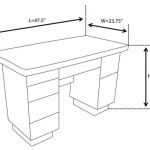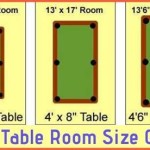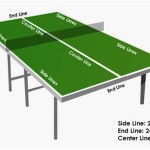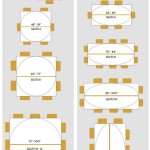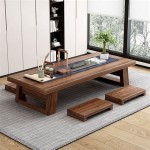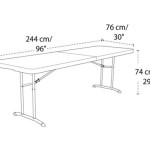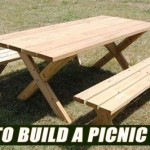Singer Sewing Machine Tables: A Legacy of Craftsmanship and Design
The Singer Sewing Machine Company, established in 1851, revolutionized the textile industry and home sewing practices. Beyond the innovation of the sewing machine itself, Singer also developed complementary furniture to house and facilitate its use. Singer sewing machine tables, reflecting the aesthetic sensibilities and technological advancements of their respective eras, have become highly sought-after items, transcending their original function to become collectible antiques and repurposed furniture pieces.
These tables were designed not only to provide a stable and convenient working surface but also to integrate seamlessly into the home environment. Early models, often crafted from solid woods like walnut or oak, showcased intricate detailing and incorporated features such as drop-leaf extensions and storage compartments. As the company expanded, different styles and variations emerged, catering to a diverse clientele and reflecting changing tastes in furniture design.
Understanding the history, construction, and unique characteristics of Singer sewing machine tables is crucial for collectors, furniture restorers, and individuals seeking to incorporate these pieces into their homes. This article will explore the key aspects of Singer sewing machine tables, including their historical context, construction techniques, and common modifications and adaptations.
Historical Significance and Evolution of Design
The development of Singer sewing machine tables mirrored the company's growth and adaptation to evolving consumer needs. In the early years, sewing machines were often large and cumbersome, requiring a sturdy and dedicated workspace. The initial tables were designed to accommodate the machine's weight and provide ample space for fabric manipulation. These early examples often featured ornate cast-iron bases, reflecting the Victorian era's penchant for elaborate decoration. The treadle mechanism, which powered the machine before the advent of electricity, was also integrated into the table design, requiring a specific configuration of pedals and connecting rods.
As sewing machines became more compact and more affordable, Singer tables evolved to reflect this shift. Portable models were introduced, often featuring folding legs and lighter materials, making them easier to transport and store. The introduction of electric sewing machines in the early 20th century further influenced the design. While some electric machines could be adapted to existing treadle tables, new models were designed with enclosed motors and integrated knee controls, leading to the development of tables specifically tailored to these features.
The Art Deco period saw the emergence of streamlined designs, incorporating geometric shapes and simplified ornamentation. Later, mid-century modern influences brought clean lines and the use of new materials like Formica and plywood. Throughout the 20th century, Singer continued to produce a wide array of sewing machine tables, ranging from simple, functional models to elaborate, decorative pieces. The variety in design reflects the changing trends in interior decor and the diverse needs of home sewers.
Construction Materials and Techniques
Singer sewing machine tables were constructed using a variety of materials and techniques, depending on the period, style, and intended price point. The earliest tables were typically made from solid hardwoods, such as walnut, oak, and cherry. These woods were chosen for their durability, stability, and attractive grain patterns. The tabletops often featured intricate veneers, inlays, or carvings, adding decorative detail and visual interest. The legs and supporting structures were typically made of cast iron, providing strength and stability to the overall structure. The cast iron was itself often ornamented with decorative flourishes.
As manufacturing processes advanced, Singer began to use more cost-effective materials, such as softwood frames with hardwood veneers, as well as the expanding use of pressed metal parts. This allowed for mass production and made the tables more accessible to a wider range of consumers. The use of cast iron persisted in many models, particularly for the legs and treadle mechanisms, but lighter-weight alternatives, such as tubular steel, also began to appear.
The construction techniques employed in Singer sewing machine tables varied depending on the era. Early tables were typically made using traditional joinery methods, such as mortise-and-tenon joints, dovetail joints, and dowel joints. These techniques ensured a strong and durable connection between the various components of the table. Later models, particularly those produced in the mid-20th century, often utilized more modern construction methods, such as screws, staples, and adhesives. These methods were faster and more efficient, but they sometimes resulted in a less robust and durable product.
The finish on Singer sewing machine tables also varied depending on the period and style. Early tables were often finished with varnish or shellac, which provided a protective coating and enhanced the natural beauty of the wood. Later models might have been finished with lacquer or paint, depending on the desired aesthetic. Understanding the original materials and construction techniques is essential for accurate restoration and preservation of these pieces.
Adaptations and Repurposing of Singer Sewing Machine Tables
Many Singer sewing machine tables have outlived their original purpose as dedicated sewing stations. As sewing practices evolved, and as vintage machines were replaced by modern, computerized models, the tables themselves became candidates for repurposing. The distinctive aesthetic and sturdy construction of these tables have made them highly desirable for a variety of new uses.
One common adaptation involves converting the table into a small desk or side table. The original tabletop can be retained, or a new top can be fabricated from wood, glass, or other materials. The drawers and storage compartments can be used to hold stationery, books, or other small items. The cast-iron base, in particular, is often appreciated for its unique industrial aesthetic and its sturdy support.
Another popular adaptation is to use the base of the sewing machine table as a stand for a sink or washbasin. This is particularly common in bathrooms or powder rooms, where the compact size of the table makes it an ideal choice for a small space. The cast-iron base can be cleaned and refinished to complement the surrounding decor. The original treadle mechanism can be retained as a decorative element.
In some cases, Singer sewing machine tables are completely disassembled, and the individual components are repurposed in other projects. The cast-iron legs can be used as supports for benches, tables, or other furniture pieces. The wooden tabletops can be used as shelves or decorative panels. The metal hardware can be used in art projects or as decorative accents. The possibilities for repurposing Singer sewing machine tables are limited only by imagination and creativity.
When adapting or repurposing a Singer sewing machine table, it is important to consider its original condition and its historical significance. While some degree of modification may be necessary to adapt the table to a new use, it is important to preserve as much of its original character as possible. Careful planning and execution can ensure that the repurposed table is both functional and aesthetically pleasing, while also respecting its historical legacy.
Beyond adaptive reuse, there is a growing interest in restoring Singer sewing machine tables to their original condition. Collectors and enthusiasts seek to preserve these pieces as examples of furniture design and industrial history. Restoration projects often involve cleaning, repairing, and refinishing the table to bring it back to its former glory. This can involve a significant amount of time and effort, but the results can be rewarding, both aesthetically and historically.
Ultimately, Singer sewing machine tables represent a fascinating intersection of history, design, and functionality. Whether they are preserved in their original condition, adapted for new uses, or simply admired as objects of beauty, these tables continue to hold a special place in the hearts of collectors, designers, and anyone who appreciates the legacy of craftsmanship and innovation that they represent.

Singer Sewing Machine Table Industrial Style Console Yakisugi Technique Custom Order Singapore

Singer Sewing Machine Table Industrial Style Console Custom Order Rainbow Yakisugi Technique Singapore

Singer Original Supply Gloss Brown Finishing The Colours And Tone Will Differs Based On Batch Due To It S Nature Ban Soon Sewing Machine Pte Ltd

Antique Singer Sewing Machine Singapore

Singer Sewing Machine Studydisplay Tablea Hobbies Toys Memorabilia Collectibles Vintage On Carou

Singer Traditional Sewing Machine 15nl Replace By 1518 Treddle With Table Amp Stand Or Electrical Portable Design Ban Soon Pte Ltd

Repurposed Old Singer Sewing Machine Furniture Makeover Diy Renovation Antique Table

What To Do With Your Singer Sewing Machine Table Hair Makeup Vanity A Spruced Up Life

Antique Singer Sewing Machine Table Vintage Hobbies Toys Memorabilia Collectibles On Carou

Repurposed Antique Sewing Machine Table For My Work Space

